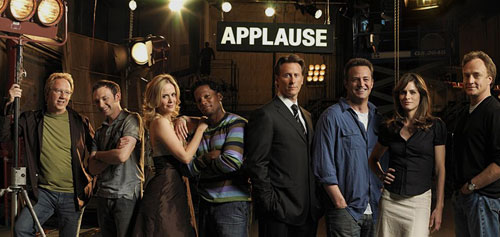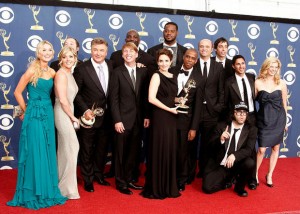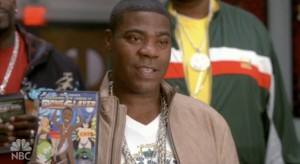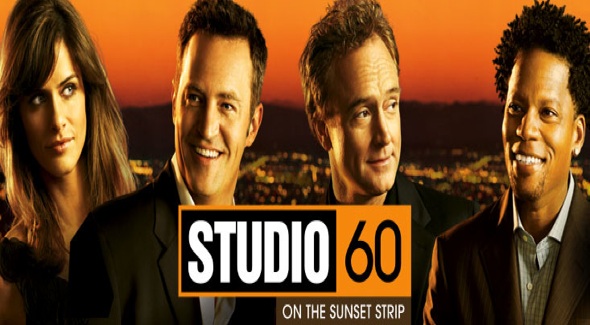[Enjoy this guest post from Orrin Reade on “Studio 60,” “30 Rock” and the real shows they satirized – Ed.]
In 2006, two heavily-hyped shows premiered on NBC with different takes on the behind-the-scenes workings of a sketch comedy show in the vein of Saturday Night Live. “30 Rock” was a half-hour sitcom created by former SNL head writer Tina Fey. It’s still on the air today, one of the most popular and successful comedies of the past few years. “Studio 60 on the Sunset Strip,” was an hour-long drama created by Aaron Sorkin (“West Wing”). That show had good initial reviews and notable moments, but was also met with a lot of legitimate criticism and was not renewed for a second season.
Saturday Night Live, which both shows are heavily based off of, started out with seven cast members. Since then the show usually has a cast size of ten to fifteen. Even then, sometimes the cast can get stretched pretty thin for certain roles (e.g., Barack and Michelle Obama). There are a lot of sketch shows that use a smaller cast: The Frank Calliendo show (1 member), Mr. Show (2 members), Upright Citizen’s Brigade (4 members). These shows generally use camera tricks or guest actors to fill in the parts they need. A show filmed in front of a studio audience that requires celebrity impressions and a variety of sketches needs a cast of at least 6 or 7 actors.
This creates an interesting screenwriting dilemma. Both shows featured a cast and a meta-cast of actors on a show-within-a-show. How do you tell the stories of the cast of the Show Within a Show (SWS) and the production staff as well?
Both shows had interesting approaches to this dilemma.
Studio 60 On the Sunset Strip
“Studio 60” had a cast size on the SWS of seven. But only three of those were in the actual show. Those three SWS cast members also got the bulk of the attention on the actual show. “Studio 60″ came up with a nickname, “The Big Three,” to explain to the audience why the producers and directors would spend so much time talking to and about just three of their cast. Supposedly, these guys were the core of the show.
Like the rest of the show, this was a sloppy plot detail that certainly merits some Overthinking.

“The Big Three” is apparently some nickname that the press gave to those three performers. It must have been an incredibly common vernacular. In the opening episode, the SWS network staff (not the show staff, mind you, but the network staff) meets to discuss a crisis. Executive Jordan McDeere (Amanda Peete) used the term “Big Three” in conversation. The out-of-touch corporate head Jack (Steven Weber) had to interrupt to ask what the “Big Three” meant, at which point the rest of the room rolled their eyes at him.
The idea that the press would dub those three actors “The Big Three” helps us suspend our disbelief as to why three of the show’s performers get so much attention. But it raises a lot of questions for which there aren’t many plausible answers. How are these three performers – Tom Jeter, Harriett Hayes and Simon Stiles – some special core group of the show that warrants their own nickname? It’s not as if they have any common thread between them. They don’t all have a prior creative history together that informs their current output (like Jorma Taccome, Akiva Goldman and Andy Samberg on SNL).
In the “Studio 60” SWS, one of the “Big Three” is the Weekend Update anchor, and the other two were actors who didn’t appear to have any common thread between them. That’s it.
Also, these three make up nearly half of a seven-person cast. People can’t agree on anything when it comes to SNL performers. They may single out one or two stars (Eddie Murphy, Will Ferrell), but no one says “this half of the cast is better than that half of the cast.” It’s hard to believe that the press would buy into the nickname “The Big Three” to that extent.
30 Rock
Because “Studio 60” took itself too seriously, unrealistic mistakes like that weigh it down. Contrast that to “30 Rock” which has the same dilemma – and is similarly unconvincing.
The show focuses on Jack and Liz, especially in the latest seasons. The A and B plots are usually devoted to Jack and Liz with the C-plot alternating between Jenna or Tracy. The remainder of the cast members on the SWS, plus Kenneth, plus the additional production staff, receive much less screentime per episode. While there are many people we’ve come to recognize – Lutz, Twofer, Cerie – the focus of the show is still on Liz.

“30 Rock” has therefore decided to compress the entirety of a show cast into Jenna, Tracy and a half-invisible third character (played first by Lonny Ross and then Cheyenne Jackson). Lonny Ross’s Josh was an active part of the plot in the first season, than started to drift into the background during seasons two and three. The show reintroduced Josh in the fourth season in an episode where the characters didn’t know he still worked there (just like the audience). This allowed “30 Rock” to do a couple plots about hiring a new cast member, who became a central part of the show for a while but has since faded into the background.
Those two have been in 46 out of the show’s 97 episodes to date, so that pretty much accounts to half a cast member. We’ve never seen a single other actor for the SWS on-screen. In addition, it does not appear that the SWS has guest stars, despite the fact that “30 Rock” itself has had plenty.
So that leaves two and a half people on the show within-a-show. This is too ridiculous to even accept as a premise. “30 Rock,” however, doesn’t ask us to suspend our disbelief. And we’re fine with that.
Sketching Out The Details
Not every great narrative asks us to suspend our disbelief. We wouldn’t criticize a theatrical production for unconvincing scenery and props, for example. There are plays that might use everything at their disposal to make the background convincing. On the other hand, a great play might use a minimalist stage design with just a couple of re-painted lamp-posts as trees. We will generally accept both because realism is a stylistic choice when it comes to theater.
TV is different. Realism is not entirely optional. If you’re going to show a house on the screen, it has to look somewhat like a house.

With “30 Rock’s” frequent breaking of the fourth wall, however, characters are aware of their genre and its limitations. Realism becomes optional. Characters in a TV show twenty years ago wouldn’t have this perspective, or this advantage. “30 Rock,” which is considered on the edge of sitcom writing for good reason, takes that a step further and has decided that certain concrete details like the size of TGS’s cast don’t have to adhere to reality. And it works. When you contrast that with “Studio 60” ‘s striving for realism, it becomes clear why one show is still around and the other isn’t.
[Did we even notice the cast size before it was pointed out to us? Do you think breaking the fourth wall is an acceptable substitute for realism? Sound off in the comments! – Ed.]

[Orrin Reade is the DC Film Industry Examiner for Examiner.com.]
“Also, these three make up nearly half of a seven-person cast. People can’t agree on anything when it comes to SNL performers. They may single out one or two stars (Eddie Murphy, Will Ferrell), but no one says “this half of the cast is better than that half of the cast.” It’s hard to believe that the press would buy into the nickname “The Big Three” to that extent.”
I disagree. Entertainment press (and the press in general) is always looking for easy storylines and if three members of the cast seem to dominate the show it’s easy to believe that the press would dub them with some facile nickname. Look at sports and all the “Big Three” talk that emerges whenever there’s three stars on a team.
As the show progressed I think it became obvious that “Big Three” was a title that just came about because of talent and seniority. Harriet Hayes wasn’t a big deal in the flashbacks that showed her early career but we’re led to believe she became a big deal because she stuck with the show for so long and was really talented.
I don’t think it’s that hard to believe that these three (who started around the same time) came into their own on the show and became mainstays among many other actors who came and went, and I think it’s very easy to believe that the press would latch onto that to create a story.
All I know is, I know people who still wont watch “30 Rock” because it’s somehow “30 Rock”‘s fault that “Studio 60” went off the air.
I felt the same way about “Chicago Hope”, but I watched “ER” anyway.
I have to say, I’m not sure this is entirely true. How many people who disliked Studio 60 really complained about the unrealistic cast size of the SWS? Most people don’t really notice, and those that do just accept that it would be too difficult to be watching a show that incorporates 10 actors on the SWS and the writers and the executive producers and the studio heads.
Look at Lost, there were supposed to be 40-something of them that survived the plane crash, but we only focus on 10. Most are barely referred to for most of the show. And this was a show that took itself seriously.
30 Rock is still on air because it is a very well written, very funny show that is enjoyed by a lot of people. Not because it doesn’t challenge us to suspend our disbelief.
And Studio 60 is not on air because life is horribly unfair. Same reason we’re not watching Arrested Development, Freaks and Geeks and Firefly every week.
I wrote the article so let me clarify.
I wasn’t pinpointing why one show failed and the other didn’t. It’s not because of how they dealt with the show-within-a-show that one failed.
(I believe the last line might have been edited differently than I wrote it, to be honest)
I’m just saying they both dealt with the dilemna different ways, and they both reflect the fates of their shows to some degree (a much smaller degree than it comes off as).
Oh, that’s right, 30 Rock used to have a character named Josh. Oh, how he’s been lost to the ages.
I don’t know if the size of the cast on the SWS really mattered to much to either show, since so little of either show is ever seen. Before the live episode, when was the last time we actually saw a sketch from TGS?
Also, while I never watched Studio 60, the main complaint I always heard was that when they showed the sketches they were never any good, despite the fact these were supposed to be brilliant, show saving sketches. You want to talk about suspension of disbelief? There you go.
Also, another sketch show with a small cast was A Bit of Fry and Laurie, which was just Stephen Fry and Hugh Laurie with the occasional bit player. Why do I mention it? Because it is very good and all four seasons are available to stream on Netflix. Go watch House before he was House!
Which shows stay on the air has nothing to do with which shows are good and which shows are bad. It’s just ratings and which shows people watch, which is really a mystery much of the time.
It’s always bothered me that TGS seems to have a cast of 3, and that one of them is barely visible. Also, you say that Jenna and Tracy have only been in 46 of the shows 97 episodes? That doesn’t sound right. There are 51 episodes that feature neither of them?
Interesting trivia: Studio 60 received higher ratings than 30 Rock all through its first season. It was cancelled because it was significantly more expensive and it was viewed as having less potential for audience growth. Clearly the audience for 30 Rock has grown significantly, so not canceling it was a good call.
Tom – 51 episodes refers to the semi-invisible third cast member (Josh and later Danny), not Jenna or Tracy.
My question is, where the hell has Cerie been this season?
She got married. They’ve got to get to work cranking out a kid, or else she’ll lose her opportunity to be a hot mom.
That’s interesting that Studio 60’s ratings were higher, since all anybody ever heard about the show was that it’s ratings were tanking (something Aaron Sorkin railed against in several interviews. Talk about the content, not the ratings, was his basic point).
What I want to know is: which NBC exec. thought it would be a good idea to have 2 shows about the same thing air the same year? Wasn’t it pretty obvious that they would be competing against each other and that only one would survive?
If there’s anything we should have learned by now, it’s that successful shows have short titles. “Studio 60 on the Sunset Strip” is an awful title. Even if you shorten it to “Studio 60,” it’s still 5 syllables, or the same # as “Malcolm in the Middle,” which people would consider a long title.
I really liked ‘Studio 60’, but I agree that its biggest failing was that the sketches they showed weren’t funny, interfering with my suspension of disbelief. The only remotely promising sketch was a Santa Claus-gets-caught-on-‘To Catch a Predator’ bit from the Christmas episode; I could picture that exact sketch being done by SNL.
I may not be happy they cancelled the show, but I’ll try not to hold the grudge too long. I’m still mad they cancelled ‘Key West’ back in the early 90s, but I don’t even remember the show that well so maybe I only liked it because I was 13 and it had Jennifer Tilly as a prostitute as a main character (along with Kelly Bundy and Kelly Kapowski, it was a good time to be pubescent).
I think AS said in an interview once that the sketches weren’t supposed to be funny. You were only seeing them in bits and pieces, and they weren’t the point anyway. Just like whatever legislation was being passed on “The West Wing” wasn’t really the point either. The point was the characters and their relationships. The sketches or the legislation or the studio or the White House were just the worlds the characters happened to be in, and a catalyst for the great dialogue.
I would like to think a good part of why Studio 60 was cancelled is because the characters weren’t engaging and the stories were contrived (even as compared to other television fare). One of my biggest complaints about the SWS talent when behind the scenes was that those characters weren’t neurotic or trying to be funny to each other. That didn’t ring true as what I believe performers to be like. The only character ever to really ring true for me was one brought in mid-run. I can’t recall his name or who played him, but he was brought in to be a writer on the SWS. He was morose and maudlin, just what I understand real comedy writers (not performers) to be.
I also really reacted badly to story lines that exonerated Sorkin’s past behavior in short order (e.g. the substance abuse problem that Matt Perry licks in one episode).
The whole show just seemed like a giant ego stroke for Aaron Sorkin, whose quality of output on TV has been a linear decline from the pinnacle of Sports Night, to the downward trend as West Wing rolled on.
I had no problem with the size of the SWS cast. At any one time, SNL has had a small handful of actors that one looks forward to seeing. And I had no problem with the sketched not being funny, as the program S60 was about the production, not the SWS. All that was required was to show the reaction to the sketches to give dramatic context (whether or not a sketch worked or bombed).
I say good riddance to S60. Sorkin’s two movies to have reached the screen since it’s demise are both well written. I think he just doesn’t have the temperament/stamina for series sausage grinding.
Patrick
This was a really interesting read, but I think you’ve made an unfair parralel with SNL and TGS. When we first meet Liz and the gang, it’s called The Girly Show, and Jenna, and only Jenna, is the star. It’s been a plot point a few times that the show hires extras to play minor roles (Jenna even bangs one of them, High Five that guy!). Josh is the only other regular cast member (pre-Tracy ofcourse), because they needed someone to play the male characters. Although Jenna probably would have played them too if they’d let her. Then Tracy comes along to make the show more edgy, and he becomes Jenna’s co-star. It makes sense that Josh sinks into the background, because now they have a different, more famous actor to play the male parts. All the other requisite roles are filled in by extras, which is how you can realistically have a show that has two famous cast members. Think Little Britain, not SNL.
“TV is different. Realism is not entirely optional. If you’re going to show a house on the screen, it has to look somewhat like a house.”
How about the original Star Trek? If you’re going to show a planet on the screen, it just has to look like a soundstage with some dirt, a rock, and a funky-colored backdrop.